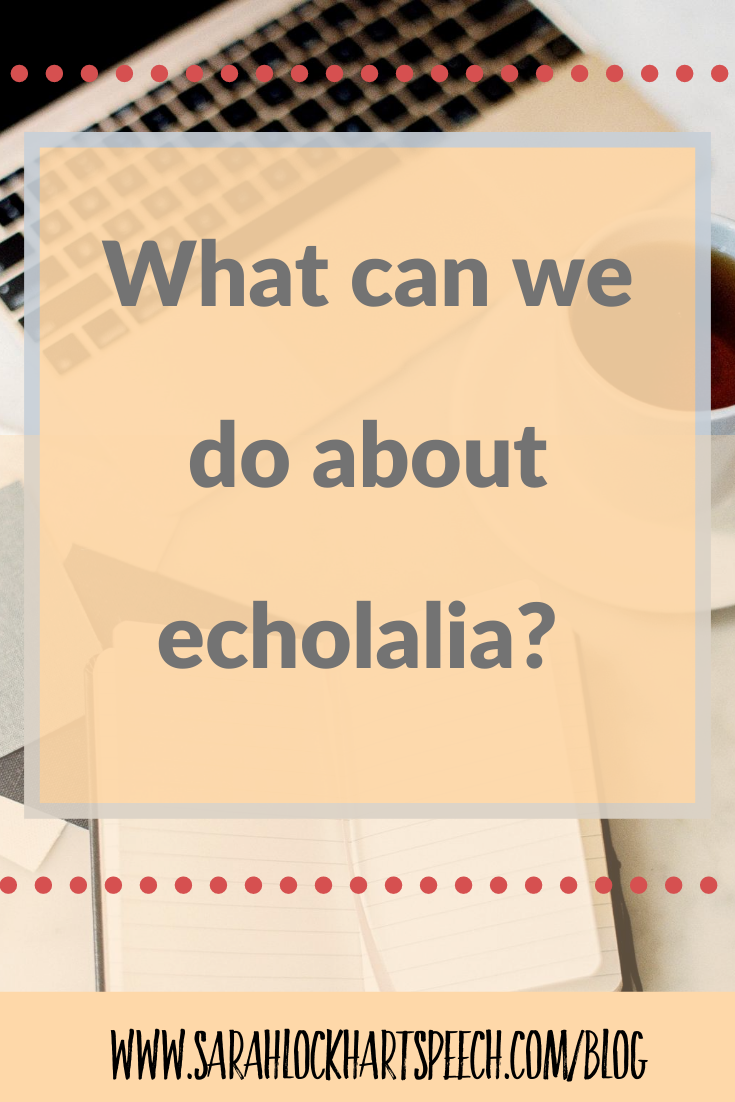Echolalia Q and A
As an SLP or parent working with children who exhibit echolalia, knowing what to do can be confusing. Is echolalia something to be extinguished? Is it meaningful? How should we respond to a child’s echolalia?
This post explores the definition of echolalia and suggestions for moving forward to students who exhibit echolalia.
Echolalia Defined
Echolalia is the repeating of words, phrases, or sentences previously heard. Echolalia commonly occurs in Autistic individuals, and is especially noticeable as these individuals build language. Echolalia can be immediate (a child repeats what you’ve just said) or delayed (a child repeats something they’ve heard earlier, i.e. in a movie). Echolalia is typically presented with an exact intonational pattern of the original unit of language heard. This repeated language can happen often and out of context, and it’s difficult to tell if the person is using this meaningfully or this is a repetitive sensory behavior.
Here are some examples:
A child loves the Toy Story movie and frequently repeats “to infinity, and beyond!” when eating a snack.
A child typically tries to run out the front door, and parents and caregivers often say “stay here, the door is locked,” and the child frequently repeats “the door is locked” throughout the day in many different routines, and this doesn’t seem purposeful.
A child loves watching Dora The Explorer and frequently says “swiper, no swiping!” during play time with peers.
Echolalia Indicates Gestalt Language Processing
Echolalia can help children process language. Children who demonstrate echolalia frequently are gestalt language learners, meaning they process language units not as stand alone words but as longer strings (phrases and sentences).
Of note, many children are gestalt language processors, not just kids with Autism. We don’t necessarily know that all children with ASD are gestalt language learners, but echolalia can be a significant sign of a gestalt language processor. As a general rule, echolalia shouldn’t be taken literally but instead we can examine some possible functions of echolalia (see next section).
Also, sometimes these units of echolalia can be very long (as in longer passages from movies). This can be especially difficult to work with because echolalia turns take so long, but remember to use the same strategies outlined in this blog post for those too.
Echolalia - What does it mean?
Unfortunately, when I was learning about echolalia, the common perspective is that echolalia was a maladaptive behavior that should be extinguished - that the goal would be to eliminate echolalia in our students. I never was quite clear on how to do that or what that meant.
Turns out, current research suggests that echolalia is a sign of gestalt language processing. This means that our students are learning units of language, typically in phrases or sentences. As our students process that language, they will repeat those phrases. These may or may not be meaningful, but they do always indicate language learning and processing.
Students can use echolalia for a variety of pragmatic purposes, for example -
To Request - A student walks up to the refrigerator and says “swiper, no swiping!” and tries to open the refrigerator. It could be this student knows that this phrase is meaningful, but isn’t sure exactly how, and wants a snack.
To Make a Choice - When given a choice between two objects, perhaps a student doesn’t point or gesture, but repeats “to infinity, and beyond!” reaching for a particular object.
To Express Rejection - When presented with a less preferred activity, a child moves away and yells “the door is locked!”
To Ask for Help - a student is trying to get a sticker off the sheet and it’s stuck, and yells “swiper, no swiping!” and looks at their communication partner.
For Self Regulation & Language Processing - What about when the echolalia doesn’t seem purposeful? It’s true that the function for echolalia is sometimes self regulation or a processing of language.
Turn Taking - sometimes children use echolalia to “take a turn” in the conversation, i.e. the content of what the child is saying isn’t purposeful, but the child knows they are supposed to talk on their turn, so they use a previously learned phrase/sentence (echolalia) for their turn.
(And more!)
This brings us to one of the most important things we’ve discussed thus far - echolalia is language learning and processing and as communication partners, we can consider the child’s intended meaning and model that language.
Here’s an example:
A parent presents bubbles to a child, waiting for an initiation or request. Student turns away and yells “the door is locked!” and pushes away with their hands.
The communication partner models “no bubbles, let’s try something else.”
Another example:
A student is trying to open modeling clay to play with but cannot open the top, and yells “swiper, no swiping!” and then attempts to open the top with their teeth.
Adult models, “help” and the adult opens the container.
Yet another example:
A child is blowing bubbles with an adult and blows through the wand, but there is no bubble solution left. The child says “the door is locked!”
Adult models, “more bubbles” and dunks the wand into the bubble solution.
Echolalia - It’s a Guessing Game
Although the above examples are situations in which the communicative intent is clearer, chances are you won’t always know what a child wants or if the echolalia is meaningful. As communication partners, we treat communication as meaningful and model appropriate language for that situation.
There are plenty of times that it may be difficult to tell if the echolalia is meaningful or how to respond. Over time, as we get to know the children we work with, we will get better at this. Take time to get to know your student, and be patient with the process.
Sometimes echolalia is sensory stimulation? Sometimes, yes. But that doesn’t mean we should ignore it or try and get rid of it. Remember that it’s language learning, and ask yourself how you can model something meaningful.
Echolalia Summary - Skills for Language Partners
When students exhibit echolalia, there are some tips for therapy which can help:
Wait for the Child to Initiate
Choose High Interest Activities
Give the Conversation “Blank Space” (quiet time)
Model a More Appropriate Response
Sources:
Steigler, L. (2020, June 29). A Language-Based Approach to Managing Echolalia. https://apps.asha.org/eweb/olsdynamicpage.aspx?title=a+language-based+approach+to+managing+echolalia+(on+demand+webinar)&webcode=olsdetails
Sarah Lockhart is a speech language pathologist in private practice in Ashland Oregon. She specializes in working with the birth to five population, particularly Childhood Apraxia of Speech and Autism.


